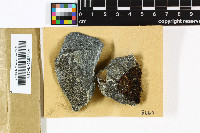
- Home
- Search
- Images
- Species Checklists
- US States: O-Z >
- US National Parks
- Central America
- South America
- US National Parks
- Southern Subpolar Region
|
|
|
|
Family: Megasporaceae
|
Magnusson, AH. 1952. Lichens from Torne Lappmark. Arkiv for Botanik, Ser. 2, 2: 185. Thallus thick with deep cracks, dark grey to brown, areolae very irregular, verrucose-uneven. Apothecia not numerous, 1-1.5 mm, innate but slightly prominent with plane, smooth disc and thin, hardly elevated margin. The type (v. varangrica) has a large, uniform, rather thick, diffract-areolate thallus, whitish- or brownish-white to brown-grey, areolae very irregular in shape, 0.3-0.6 mm wide, angular with deep, abrupt cracks, continuously dividing, surface slightly unevenly convex, opaque, I-, KOH-, CaCl-, Pd-, no hypothallus visible.—Cortex 32-40 µ thick, colourless with uneven, diffuse upper side, cells in water 3.5-?.5 µ, +/- thick-walled. Algae 8-15 µ diam. in a 50 µ thick, continuous stratum. Medulla colourless, translucid, with scanty air, hyphae distinct, densely intricate, only globose cells visible. Apothecia as young innate, then appressed, 0.7-1 mm broad, black, scabrid, somewhat convex, almost from the beginning surrounded by a black, slightly prominent margin, finally excluded.—Sections with thallus 0.6-0.9 mm thick with 0.3 mm deep apothecium. Exciple only 35-50 µ thick at edge, exterior 17 µ dark sordid brown, inside paler, laterally to 100 µ thick, +/- pale brown, to be followed 200 µ inwards but diffuse at centre in median sections, I-, KOH+ pale yellow brown. In young apothecia algae are found close to the thecium. Hypothecium 50-100 µ, colourless, limits diffuse, I+/- blue. Thecium (100) 120 µ high, colourless, I+ green-yellow to yellow-red; upper 10-12 µ (yellowish-)olive, HNO3+ bright blue-green, KOH+ pale yellow-brownish, producing a faint, granular solution. Paraphyses +/- contiguous, 1.7-2 µ, +/- distinctly thin-walled in water, in KOH free, hardly moniliform, upper 5-7 joints globose, 3-3.5 µ or oblong 6-7 X 2.5-3 µ, lower part short-celled. Asci 85-100 X 17-22 µ. Spores 17-25 X 10-12 µ. Authenticated specimens from E. Finmark: Nyborg, and Varanger, Carlebotten 1857, coll. TH. FR. (U.). In the latter there are globose pycnidia, 200 µ diam., with flattened, dark brown top and plicate wall. Con. 9-11 X 0.7-1 µ, straight. The inner structure of v. dovrina (collected by M.N. Blytt in Dovre) agrees with the type like the reactions and conidia. Probably v. dovrina is overfed and deformated (sic). My specimen is almost blackish (resembling Buellia atrata) but verrucose like the Uppsala specimen. In spite of the lecideine margin of the apothecia, L. aspicilioidea must be considered as a Lecanora species, quite agreeing in inner structure with the bulk of the L. gibbosa-group, and with Aspicilia-green in the epithecium. Lecidea superlata VAIN. which he compares with L. aspicilioidea must belong here according to the description. |












